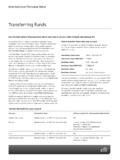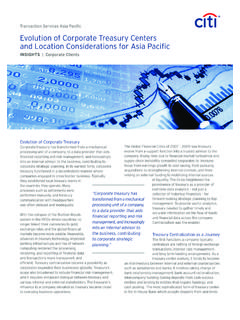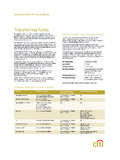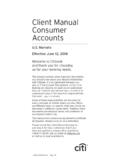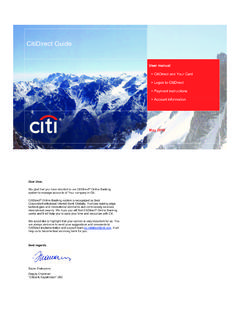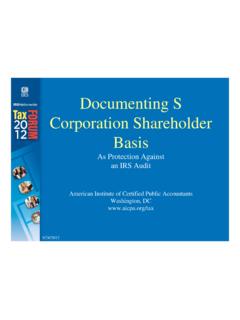Transcription of The Cash Investment Policy Statement - Citi.com
1 EQUITIESFIXED INCOMEREAL ESTATELIQUIDITYALTERNATIVESBLACKROCK SOLUTIONSThe Cash Investment Policy StatementDeveloping, documenting and Maintaining a Cash Management Plan3 Topics Covered: I. What Is an IPS?II. Getting StartedIII. Important Considerationsa. Risk Toleranceb. Portfolio Objectivec. Benchmarkd. Investment ManagerIV. Components of an IPS DocumentThe Cash Investment Policy Statement (IPS)The face of the cash management industry is changing. Oncethought of as a homogeneous, no-risk asset class, the cashmarket is now recognized as multi-faceted, complex and, to besure, subject to risk. For corporate treasurers who have yet toestablish or have not recently evaluated their existing cashinvestment policies, now is the time. In the following pages, we examine the issues surrounding the cash Investment policystatement and offer institutional investors some suggestions andbest practices for establishing, updating and/or maintaining thisimportant roadmap for managing their company s USE WITH QUALIFIED INSTITUTIONS opinions expressed are as of 15 August 2009, and may change as subsequent conditions vary.
2 4 What Is an IPS?An IPS is a document designed to identify the goals and objectives for a company sinvestment portfolio(s), as well as allowable parameters for achieving those document generally contains specific information about a company s risk toleranceand liquidity needs. The IPS should be broad, yet explicit in terms of speaking, an IPS also should be: Specific to each company s situation, Dynamic and flexible to meet current market and firm needs, Able to adapt to changing needs, but reflect total risk tolerance, and Easily modified (with proper analysis and approvals).Having a documented Policy for the administration of the company s cash is amongthe most effective means of risk management, serving as a clear and constantreminder of the firm s goals and ability to tolerate risk.
3 We believe the IPS shouldbe part of every firm s risk management protocol, incorporated into an annualboard review process (typically by the audit committee) and updated on a regularbasis. It will be important to determine: How the Policy will be reviewed and modified on an ongoing basis, Who should be involved in that review process, Who has ultimate decision-making authority, and The frequency and timeframe for such a review (annually, semiannually).In short, an effective IPS provides a means for communicating the objectives forand permitted level of risk in a company s cash portfolio. The IPS should provideguidelines for those responsible for management of the company s cash, whetherthat be an internal or external manager. Typically, these parameters should bereviewed in detail with potential managers as part of the due diligence process to ensure that the company and the party(ies) responsible for the management of its cash share mutual philosophies and assumptions, particularly where vaguelanguage may to the CFA Institute, an IPS addresses the client s risk tolerance,return requirements and all investmentconstraints (including time horizon, liquidityneeds, tax concerns, legal and regulatoryfactors, and unique circumstances).
4 TheIPS also should identify and describe theroles and responsibilities of the parties tothe advisory relationship and investmentprocess, as well as schedules for reviewand evaluation. 5 Getting StartedBefore developing an IPS, it is important to conduct a thorough evaluation of thecompany s cash needs and to pinpoint its risk profile. Effective forecasting ofliquidity needs and assessment of risk tolerance allows for the best opportunity to achieve excess returns within a cash an initial step, the appropriate staff should inventory the company s cash flowforecasts, including payroll, buyback plans and shareholder dividend payments, aswell as any other data that could affect the level of cash on the corporate balancesheet. This process serves to quantify how much cash is available for strategicinvestment.
5 Additionally, staff should consider whether there are any company-specific or unique restrictions to be factored into the cash IPS. These might includecovenants or bond indentures that may govern permissible , it is important to assess company priorities. To that end, ask the questions:What is the general course of the company and where is cash likely to be deployed( , toward acquisitions, to fund operations or more likely toward capitalexpenditures)? Answering these questions can help to ensure that the company streasury staff, which is responsible for overseeing the corporate cash strategy, issharply attuned to the broader objectives of the firm. Of equal importance is obtaininga good understanding of the company s outlook, taking into account the organization sview of the economy and the industry in which it functions.
6 When constructing a cashportfolio, it is important to understand how and when the company may potentiallyneed cash. Forward knowledge of a cash need be it months, weeks or just daysahead can have a beneficial impact on expected returns. Having a thorough graspof expected liquidity needs often can provide more opportunity for excess returnswith less risk than a broader set of allowable investments in longer or lower-ratedsecurities, but with uncertain there, treasury and finance staff is better equipped to judge the overall make-up of the company s cash, a central concept that every corporate treasurer needsto understand when developing an IPS. In fairly simplistic terms, a company s cashcan fall into three distinct categories: Operating cash, working capital required to meet daily needs of the business.
7 Core cash, which is generally earmarked for unknown future needs of the company. Strategic cash, the stable balance sheet assets not intended for specificexpenditures. While still conservative by nature, strategic cash which typicallyhas a longer time horizon than operating cash or core cash might have more of a total return objective. There are many questions to be answeredwhen developing an IPS. Among them: How does the company identify andmeasure risk in cash investing? How much risk is the company willingto take in its cash accounts? What is the company s cashinvestment objective? What is the appropriate benchmarkfor the company s cash portfolio? Should the assets be managed internallyor by an external manager?Categories of CashOperating CashCore CashStrategic CashInvestment Horizon0-6 months6-12 months12-24 monthsLiquidity NeedsRegular accessto cashOccasional accessto a portion of cashVaries; accessibilitydetermined priorto investmentInvestment FocusLiquidityLow-risk,incremental returnOptimization of returns6 Important ConsiderationsEach company s cash Investment Policy will be as unique as the company itself,factoring in the firm s liquidity needs, the general state of the industry in which itoperates, broader economic trends and the size of the cash pool.
8 The firm s specificsituation will dictate the Policy constraints and benchmark for the cash a company s Investment Policy ultimately will be customized, there are severalimportant factors that all corporations should take into account when developinga Policy . Each of them risk tolerance, portfolio objective, benchmark and investmentmanager is described ToleranceRisk tolerance is arguably the most important criterion upon which to begin buildinga cash Investment Policy . As a first step, company management must determine ifthe key priority is preservation of capital or maximization of returns. This determinationmay be made for cash as an asset class or for each category of cash the companymaintains ( , operating, core and strategic). As a next step, consider whether,within each category, there is an ability to weather any deterioration in can come in many forms for example, short-term volatility, technical pressures(supply/demand) or headline risk, to name just a few.
9 The impact on the company scash portfolio can differ based on the ability to navigate these variables. Conventional Investment wisdom suggests that higher returns are accompaniedby higher levels of risk. However, as noted above, there are different types of riskto consider, some of which may be more tolerable than others given the potentialreward. Quantifying such variables can be a difficult task, but considering thesequestions can help corporate treasurers frame their company s risk tolerance:Types of RiskPrimary RisksDefinitionFactorsCredit RiskRisk that a security s value willchange due to a ratings downgradeor, in the case of a distressedsecurity, default Rating downgrade DefaultInterest Rate RiskRisk that a security s value willchange due to a change in interestrates or the shape of the yield curve Change in the level ofinterest rates Change in the shape of the yield curveLiquidity RiskRisk that arises from the difficultyof selling an asset.
10 Security cannotbe bought or sold quickly enough to prevent or minimize a loss Secondary market bidavailabilitySpread RiskRisk of change in value of asecurity due to a change in therelative spreads in the market Hybrid of credit and liquidity risk7 What types of risk are acceptable?Can the company cope with lack of liquidityfor a short or extended period of time? Is there ever a circumstance where lossof principal is acceptable? Is the company prepared to weather volatility in returns?If so, how much isacceptable monthly, quarterly or only annual bouts of volatility? How does the business perform in different market cycles?And, to what extentis this correlated to the Investment markets? How much diversification of investments is desired?It is not uncommon for apolicy to incorporate parameters that do little to contain risk-taking, but do limitthe portfolio in terms of diversification.

